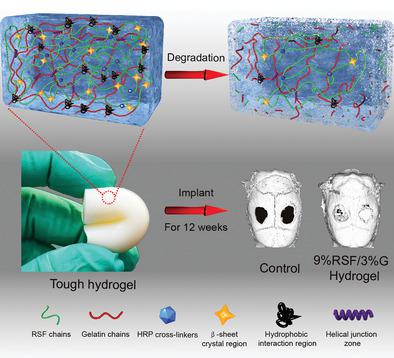当前位置:
X-MOL 学术
›
Adv. Funct. Mater.
›
论文详情
Our official English website, www.x-mol.net, welcomes your
feedback! (Note: you will need to create a separate account there.)
Salt‐Assisted Toughening of Protein Hydrogel with Controlled Degradation for Bone Regeneration
Advanced Functional Materials ( IF 18.5 ) Pub Date : 2019-04-26 , DOI: 10.1002/adfm.201901314 Li‐Bo Jiang 1 , Di‐Han Su 1 , Sheng‐Long Ding 1 , Qi‐Chen Zhang 1 , Ze‐Fang Li 1 , Fan‐Cheng Chen 1 , Wang Ding 1 , Shu‐Tian Zhang 1 , Jian Dong 1
Advanced Functional Materials ( IF 18.5 ) Pub Date : 2019-04-26 , DOI: 10.1002/adfm.201901314 Li‐Bo Jiang 1 , Di‐Han Su 1 , Sheng‐Long Ding 1 , Qi‐Chen Zhang 1 , Ze‐Fang Li 1 , Fan‐Cheng Chen 1 , Wang Ding 1 , Shu‐Tian Zhang 1 , Jian Dong 1
Affiliation

|
Recently, strong polymer‐based hydrogels have been intensively investigated. However, the development of tough protein hydrogels with controlled degradation for bone regeneration has rarely been reported. Here, regenerated silk fibroin/gelatin (RSF/G) hydrogels with both strength and controlled degradation are prepared via physically and chemically double‐crosslinked networks. As a representative example, the 9%RSF/3%G hydrogel shows approximately 80% elongation and a compressive and tensile modulus of up to 0.25 and 0.21 MPa, respectively. It also shows a degradation rate that can be adjusted to approximately three months in vivo, a value between that of the rapidly degrading gelatin hydrogel and the slowly degrading RSF hydrogel. The 9%RSF/3%G hydrogel has good biocompatibility and promotes the proliferation and differentiation of bone marrow–derived stem cells compared with the control and pure RSF hydrogels. At 12 weeks after implantation of the gel in a calvarial defect, micro‐computed tomography shows greater bone volume and bone mineral density in the 9%RSF/3%G group. More importantly, histology reveals more mineralization and enhancements in the quality and rate of bone regeneration with less of a tissue response in the 9%RSF/3%G group. These results indicate the promising potential of this tough protein hydrogel with controlled degradation for bone regeneration applications.
中文翻译:

盐辅助增韧降解的蛋白质水凝胶可促进骨再生
最近,对基于聚合物的强力水凝胶进行了深入研究。但是,很少有报道报道了具有可控降解的强韧蛋白质水凝胶可用于骨骼再生。在此,通过物理和化学双交联网络制备了具有强度和可控降解性能的再生丝素蛋白/明胶(RSF / G)水凝胶。作为一个代表性的例子,9%RSF / 3%G水凝胶的伸长率约为80%,压缩模量和拉伸模量分别高达0.25和0.21 MPa。它还显示了可以在体内调整到大约三个月的降解速率,该值介于快速降解的明胶水凝胶和缓慢降解的RSF水凝胶之间。与对照和纯RSF水凝胶相比,9%RSF / 3%G水凝胶具有良好的生物相容性,并促进了骨髓干细胞的增殖和分化。在颅骨缺损处植入凝胶后12周,显微计算机断层扫描显示9%RSF / 3%G组的骨体积和骨矿物质密度更高。更重要的是,在9%RSF / 3%G组中,组织学揭示了更多的矿化作用和骨骼再生的质量和速率的提高,而组织反应却更少。这些结果表明,这种具有韧性的蛋白质水凝胶具有可控的降解潜力,可用于骨骼再生应用。微型计算机断层扫描显示9%RSF / 3%G组的骨量和骨矿物质密度更高。更重要的是,在9%RSF / 3%G组中,组织学揭示了更多的矿化作用和骨骼再生的质量和速率的提高,而组织反应却更少。这些结果表明,这种具有韧性的蛋白质水凝胶具有可控的降解潜力,可用于骨骼再生应用。微型计算机断层扫描显示9%RSF / 3%G组的骨量和骨矿物质密度更高。更重要的是,在9%RSF / 3%G组中,组织学揭示了更多的矿化作用和骨骼再生的质量和速率的提高,而组织反应却更少。这些结果表明,这种具有韧性的蛋白质水凝胶具有可控的降解潜力,可用于骨骼再生应用。
更新日期:2019-04-26
中文翻译:

盐辅助增韧降解的蛋白质水凝胶可促进骨再生
最近,对基于聚合物的强力水凝胶进行了深入研究。但是,很少有报道报道了具有可控降解的强韧蛋白质水凝胶可用于骨骼再生。在此,通过物理和化学双交联网络制备了具有强度和可控降解性能的再生丝素蛋白/明胶(RSF / G)水凝胶。作为一个代表性的例子,9%RSF / 3%G水凝胶的伸长率约为80%,压缩模量和拉伸模量分别高达0.25和0.21 MPa。它还显示了可以在体内调整到大约三个月的降解速率,该值介于快速降解的明胶水凝胶和缓慢降解的RSF水凝胶之间。与对照和纯RSF水凝胶相比,9%RSF / 3%G水凝胶具有良好的生物相容性,并促进了骨髓干细胞的增殖和分化。在颅骨缺损处植入凝胶后12周,显微计算机断层扫描显示9%RSF / 3%G组的骨体积和骨矿物质密度更高。更重要的是,在9%RSF / 3%G组中,组织学揭示了更多的矿化作用和骨骼再生的质量和速率的提高,而组织反应却更少。这些结果表明,这种具有韧性的蛋白质水凝胶具有可控的降解潜力,可用于骨骼再生应用。微型计算机断层扫描显示9%RSF / 3%G组的骨量和骨矿物质密度更高。更重要的是,在9%RSF / 3%G组中,组织学揭示了更多的矿化作用和骨骼再生的质量和速率的提高,而组织反应却更少。这些结果表明,这种具有韧性的蛋白质水凝胶具有可控的降解潜力,可用于骨骼再生应用。微型计算机断层扫描显示9%RSF / 3%G组的骨量和骨矿物质密度更高。更重要的是,在9%RSF / 3%G组中,组织学揭示了更多的矿化作用和骨骼再生的质量和速率的提高,而组织反应却更少。这些结果表明,这种具有韧性的蛋白质水凝胶具有可控的降解潜力,可用于骨骼再生应用。
















































 京公网安备 11010802027423号
京公网安备 11010802027423号